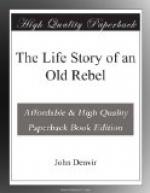The Orange attack was of short duration. They were simply cleared out as if by an irresistible whirlwind. We have always been able to hold our own in Liverpool, when it came to physical encounters against all comers. We have generally had some organisation or another—whether constitutional or unconstitutional—but, apart from this, the nature of the employment of our working-men, especially in O’Connell’s time, brought them together in such a way that large numbers of them knew each other, and could act together in case of emergency.
MacManus, who had command of the stewards on the night of the attack, knew a number of men like Mick Digney, who was what was called a “lumper”—that is, a contractor in a small way who took work in the “lump” and employed men for loading and unloading ships. Digney and other friends would find their way for consultation and the making of the necessary arrangements beforehand on occasions like this to MacManus, whose place of business—he was an extensive forwarding agent—was one of those half-offices, half-warehouses, which used to be in North John Street.
Another class of men who were reliable for such occasions were the bricklayers’ labourers. Of course, it is different now—and a sure sign that our people are rising in the social scale—but in those years, and long afterwards, I never knew a bricklayers’ labourer who was not an Irishman.
The frequent mention at these gatherings of a sterling Irishman I knew well in after years, Patrick O’Hanlon, reminds me of two friends of my father of the same name who belonged to another class of men, the wood-sawyers, who, at that time, were mostly Irish. They had not exactly the same name as Patrick, for it was not so customary to use the O’ or Mac in those days as it has since become. Not that Hughey and Ned Hanlon did not know that they were entitled to the honourable Gaelic prefix, but, with the good nature which is rather too characteristic of Irishmen sometimes, those who had preceded them had allowed other people to drop the O’ in using their name, until it became rather difficult to resume it.
Needless to say that Hughey and Ned Hanlon, John Green, Mike Doolan, and other wood-sawyers were at the Royal Amphitheatre among MacManus’s volunteers. The Hanlons, in particular, were fine lathy men, without an ounce of spare flesh, but they had sinews of iron. Hughey used to come to our house with other neighbours every week to hear the “Nation” read, and the songs in it sung to the accompaniment of Harry Starkey’s or my Uncle John’s fiddle. The Hanlons were North of Ireland men, and Hughey often used to proudly tell us that the O’Hanlons were the Ulster standard-bearers.
At that time, besides the Amphitheatre, where during those years several Irish demonstrations were held, a popular place for our gatherings was the Adelphi Theatre (previously the “Queen’s"), which was in somewhat better standing then than afterwards, though it, too, has had within its walls most of the Irish leaders of the last half century.




